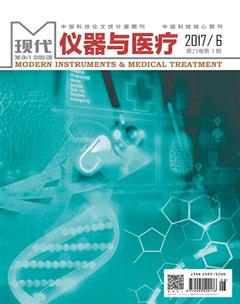应用肠道解痉剂对结肠息肉检出率的影响
蒋军+杜林枫
[摘 要] 目的:分析使用肠道解痉剂对结肠息肉检出率的影响。方法:1592例接受肠镜检查者,注射东莨菪碱的559例为观察组,未使用肠道解痉剂的1033例为对照组,比较两组患者结肠息肉检出率。结果:两组受试者进镜时间、退镜时间、不良反应发生率比较,差异无统计学意义(P>0.05)。观察组结肠息肉检出率为97.37%,高于对照组的82.33%,肠道蠕动程度弱于对照组,差异均有统计学意义(P<0.05)。结论:使用肠道解痉剂对于提高结肠息肉检出率具有积极意义,且无明显副作用。
[关键词] 肠道解痉剂;东莨菪碱;结肠息肉;检出率
中图分类号:R57 文献标识码:A 文章编号:2095-5200(2017)03-115-03
DOI:10.11876/mimt201703048
[Abstract] Objective: This study was designed to investigate the effect of intestinal antispasmodic agents on the detection rate of colonic polyps. Methods: Among 1592 patients who underwent enteroscopy, 559 patients injected into scopolamine were selected as the observation group, and 1033 have not been injected intestinal antispasmodics as the control group. The detection rate of colonic polyps was compared between the two groups. Results: There was no significant difference between the two groups in the time of insertion, the time of retraction, the incidence of adverse reactions (P>0.05). The detection rate of colonic polyps in the observation group was 97.37%, which was higher than 82.33% of the control group, and the degree of intestinal peristalsis was weaker than that of the control group (P<0.05). Conclusions: The use of intestinal antispasmodic agent can improve the detection rate of colonic polyps and have no obvious side effects.
[Key words] intestinal antispasmodic; scopolamine; colon polyp; detection rate
随着居民饮食习惯的改变,我国结肠息肉发病率呈上升趋势,而结肠息肉、腺瘤被认为是结直肠癌的发病基础,因此,早期准确筛查结肠息肉对于降低结直肠癌发生风险及病死率具有重要意义[1]。肠镜是检出结肠息肉的重要手段,但肠镜检查易受肠道蠕动、肠道清洁度等多种因素影响,准确度有待提高[2]。作为一种肠道解痉剂,东莨菪碱多用于麻醉镇痛、止咳平喘,也具有抑制肠道平滑肌蠕动作用,有望提高肠镜下结肠息肉检出率[3]。为验证上述假设,本研究积累了1592例资料进行分析。
1 资料与方法
1.1 对象
2010年4月—2016年4月于我院接受肠镜检查及病理组织学检查患者排除肠道准备不佳及肠镜无法达到回盲部者[4]入组。1592例中注射东莨菪碱的559例(观察组),未使用肠道解痉剂的1033例(对照组)。两组受试者年龄、体质量指数(BMI)、性别、波士顿肠道准备量表评分(7.13±0.52vs7.19±0.53),差异无统计学意义(P>0.05)。
1.2 方法
肠镜检查前3 d予少渣饮食,手术当日清晨口服2 L复方聚乙二醇电解质溶液,行规范肠道准备[5]。以1.5 mg/kg丙泊酚静脉注射麻醉,观察组加用0.3 mg東莨菪碱(上海禾丰制药有限公司,国药准字H31021519)静脉注射,待患者睫毛反射消失后行无痛肠镜检查[6],检查过程中根据患者体动情况酌情追加丙泊酚。
记录进镜时间与退镜时间、结肠息肉检出率、肠道蠕动情况及不良反应发生情况。结肠息肉检出率以病理检查为金标准;肠道蠕动情况根据肠壁收缩间隔时间进行评
估[7]:弱为间隔时间>10 s;中为间隔时间5~10 s;强为间隔时间<5 s。
数据采用SPSS18.0进行分析,以P<0.05为差异有统计学意义。
2 结果
1592例受试者中,病理检查确诊266例结肠息肉,占16.71%。观察组结肠息肉检出率为97.37%,高于对照组的82.33%,观察组肠道蠕动程度弱于对照组,差异有统计学意义(P<0.05)。两组受试者进镜时间、退镜时间比较,差异无统计学意义(P>0.05)。见表1。
观察组术后发生头晕嗜睡81例、恶心呕吐52例,不良反应发生率为23.79%;对照组术后发生头晕嗜睡151例、恶心呕吐93例,不良反应发生率为23.62%,两组患者不良反应发生率比较,差异无统计学意义(P>0.05)。
3 讨论
在無痛肠镜检查过程中,由于不同医生的操作手法不同,且患者自身肠道生理结构存在差异,肠道受牵拉作用影响可能出现收缩现象,而剧烈的肠道蠕动可能对检查准确度造成严重影响[8]。有学者认为,肠道蠕动与麻醉过浅具有密切关联,但在实际临床实践中,盲目增加麻醉药物剂量往往不仅无法有效缓解胃肠蠕动,还可能增加呼吸循环并发症发生风险[9]。
东莨菪碱是一种人工合成的M胆碱受体阻滞剂,其作用途径与阿托品相近,可拮抗乙酰胆碱所致平滑肌痉挛与心血管抑制,具有强效肠道解痉作用[10]。本研究观察组受试者在常规麻醉药物的基础上加用肠道解痉剂东莨菪碱,其进镜时间、退镜时间未见明显变化,说明东莨菪碱不会对肠腔视野、检查时间造成明显影响,故不会增加麻醉意外风险。而在结肠息肉检出率的观察中,可以发现,以病理检查为金标准,观察组受试者结肠息肉检出率达到97.37%,明显高于对照组的82.33%,尤其是在腺瘤性息肉、炎性息肉检出率方面,加用肠道解痉剂具有明显优势,这主要得益于东莨菪碱的肠道蠕动抑制作用[11-12]。作为肠镜筛查有效性的重要衡量指标,腺瘤性息肉、炎性息肉的检出不仅能够降低微小、平坦息肉的漏检率,亦可指导早期肠镜下切除,避免息肉恶变,降低结直肠癌发生率[13]。
大量数据显示,年龄超过40岁后,结肠息肉发病率呈明显上升趋势[14],因此,美国结直肠癌早期筛查指南中强调,推荐≥50岁的普危人群接受结直肠癌、结肠息肉早期筛查,通过肠镜早期检出结肠息肉并实施息肉电切术治疗,对于结直肠癌发病率的控制具有重要意义[15-17]。故在提高结肠息肉检出率的基础上,保证肠镜检查的安全性也至关重要。本研究结果示,加用肠道解痉剂并未导致患者术后头晕嗜睡、恶心呕吐等不良反应发生风险上升,即肠道解痉剂的使用不会增加中枢神经系统症状发生率,说明该方案的安全性值得肯定。
此外,亦有学者发现,东莨菪碱在抑制肠道蠕动的同时,还可对抗迷走神经、兴奋循环中枢,拮抗麻醉药物所致呼吸循环抑制,故使用肠道解痉剂还具有稳定受试者循环系统、提高麻醉安全性的优势[18]。特别是对于存在高血压、心脏病的受试者而言,加用东莨菪碱有望进一步保证麻醉深度、降低麻醉风险,关于该方向的分析,有待日后前瞻性对照研究加以明确。
参 考 文 献
[1] Salama A K, Ali H M. Comparative study of hyoscine doses as antisialagogue for patients receiving ketofol sedation undergoing colonoscopy procedures[J]. Anesth Essays Res, 2016, 10(1): 94.
[2] 刘岚. 7298例结肠镜检查结果分析[D]. 济南:山东大学, 2010.
[3] Ristikankare M, Karinen-Mantila H. The role of routinely given hyoscine-N-butylbromide in colonoscopy: a double-blind, randomized, placebo-controlled, clinical trial[J]. Scand J Gastroenterol, 2016, 51(3): 368-373.
[4] Sanagapalli S, Agnihotri K, Leong R, et al. Antispasmodic drugs in colonoscopy: a review of their pharmacology, safety and efficacy in improving polyp detection and related outcomes[J]. Ther Adv Gastroenter, 2017, 10(1): 101-113.
[5] Sajid M S, Caswell J, Bhatti M I, et al. Carbon dioxide insufflation vs conventional air insufflation for colonoscopy: a systematic review and meta‐analysis of published randomized controlled trials[J]. Colorectal Dis, 2015, 17(2): 111-123.
[6] 姜元喜, 陈莹, 李信, 等. 结直肠癌筛查高危患者结肠镜下息肉与腺瘤检出率的影响因素[J]. 中华消化内镜杂志, 2015, 32(10): 649-652.
[7] Fukuzawa M, Uematsu J, Kono S, et al. Clinical impact of endoscopy position detecting unit (UPD-3) for a non-sedated colonoscopy[J]. World J Gastroenterol, 2015, 21(16): 4903.
[8] 许松欣, 邓彬, 高雪峰, 等. 肠道解痉剂对结肠息肉检出率影响的Meta分析[J]. 中华胃肠外科杂志, 2015, 18(6): 593-596.
[9] Kiriyama S, Naitoh H, Fukuchi M, et al. Evaluation of abdominal circumference and salivary amylase activities after unsedated colonoscopy using carbon dioxide and air insufflations[J]. J Dig Dis, 2015, 16(12): 747-751.
[10] Kanazawa H, Utano K, Kijima S, et al. Combined assessment using optical colonoscopy and computed tomographic colonography improves the determination of tumor location and invasion depth[J]. Asian J Endosc Surg, 2017, 10(1): 28-34.
[11] Yamamoto K, Michida T, Nishida T, et al. Colorectal endoscopic submucosal dissection: Recent technical advances for safe and successful procedures[J]. World J Gastrointest Endosc, 2015, 7(14): 1114-28.
[12] 何晉德, 刘玉兰, 王怀堂. 常规电子结肠镜检查中结肠息肉漏诊分析[C]// 中华医学会第七次全国消化病学术会议论文汇编(下册). 2007:354-356.
[13] Corte C J, Leong R W. Improving the utility of colonoscopy: Recent advances in practice[J]. J Gastroenterol Hepatol, 2016, 31(1): 32-44.
[14] Rondonotti E, Andrealli A, Amato A, et al. Technical interventions to increase adenoma detection rate in colonoscopy[J]. Expert Rev Gastroenterol Hepatol, 2016, 10(12): 1349-1358.
[15] 步召德, 季加孚. 2008年版NCCN结肠癌临床实践指南解读[J]. 世界华人消化杂志, 2009, 17(4):343-346.
[16] Evans J, Essex A, Xin H, et al. Registered report: Wnt activity defines colon cancer stem cells and is regulated by the microenvironment[J]. Nature Cell Biology, 2015, 12(5):468-476.
[17] Tanaka S, Kashida H, Saito Y, et al. JGES guidelines for colorectal endoscopic submucosal dissection/endoscopic mucosal resection[J]. Dig Endosc, 2015, 27(4): 417-434.
[18] Watanabe Y, Yamaji Y, Kobayashi Y, et al. Association between colorectal polyps and hypertension treatment[J]. J Dig Dis, 2015, 16(11): 649-655.

